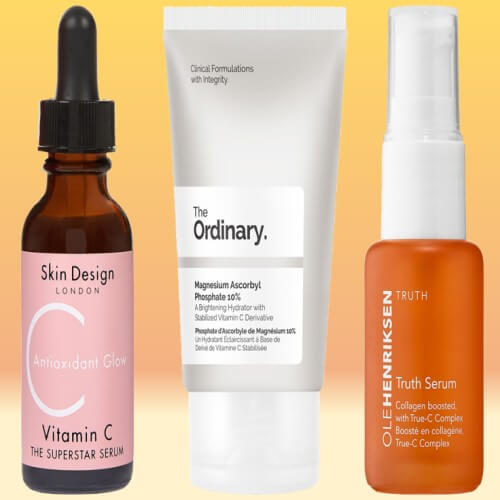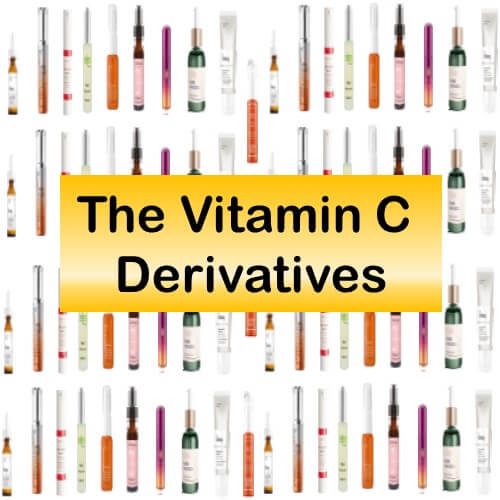I love collecting data as it enables you and I to make better informed decisions….So when I had to go through 200+ ingredient labels of Vitamin C products – yup, it was like Christmas had come early.
Am I kidding? Yes, this was an excruciating exercise because so many products exist around Vitamin C and so few are worth paying attention to.
This is my penultimate blog on Vitamin C serums for a while and of course, this is a technical, geeky blog.
Vitamin C derivatives
You rarely see Vitamin C on a topical formulation. What you are more likely to see is:
- L-Ascorbic Acid, which appears about 50 per cent of the time
- One of L-Ascorbic Acids many derivatives, present in this order:
- Ascorbyl tetraisopalmitate – most common
- Tetrahexyldecyl Ascorbate (THD Ascorbate)
- Ethyl Ascorbic Acid
- Magnesium Ascorbyl Phosphate (MAP) and Sodium Ascorbyl Phosphate (SAP)
Why are Vitamin C derivatives so important?
L-Ascorbic Acid is amazing: there are tons of clinical data/studies proving its anti-oxidant activity against free radicals (therefore also delivers photoprotection), inhibits melanin synthesis (so a skin brightener/whitener) and is essential to collagen synthesis.
BUT (always a but), its so unstable and extremely difficult to work with, especially if you are a manufacturer. How can you produce a million bottles of an ingredient that refuses to play ball?
To deal with this, manufacturers have devised different ways of delivering STABILISED L-Ascorbic Acid, including using only L-Ascorbic Acid derivatives, as generally, these are:
- Stable at different pHs
- Lipid or fat soluble, which means they can be included in topical treatments such as your face cream etc
- Don’t readily oxidise, which is good for the product stability (the product doesn’t start to become ineffective as soon as it comes out a tube)…
All these make formulating a product with derivatives easier and (in theory) manufacturers can make better Vitamin C products with a longer shelf life. (And I get it: I am using Clinique’s Vitamin C 10% serum and on day one its a white colour but by day four I can see its yellow, showing rapid oxidation of L-Ascorbic Acid)
Derivatives sound amazing. Why are they not more common?
There are two “problems.”
First, they have to be absorbed by the skin. You can use the best derivatives but if the skin is able to only absorb 0.00001%, then that is a crap result.
Second, they have to be converted to L-Ascorbic Acid inside our tissues.
What do I think?
Using derivatives is an excellent idea, but its important to remember that for most derivatives:
- Getting the derivative up to the same concentration as L-Ascorbic Acid in a product is extremely difficult. The maximum concentration appears to be 10% and if I find better data, I’ll provide an update.
- A derivative’s anti-oxidant activity against free radicals is likely to be much less than L-Ascorbic Acid – it’s a natural consequence of being more stable.
- You should be very weary about paying a premium for derivative products because the alternative is stabilised L-Ascorbic Acid, that delivers results (see this blog).
All that remains is to talk about the most common derivatives that I found:
Ascorbyl Tetraisopalmitate
The Korean Food & Drug Administration recognises 8 ingredients, including Ascorbyl Tetraisopalmitate at 2% as a skin whitening agent (or in more politically correct terms), a skin “brightener.”
I also found a number of patent applications that favour this Vitamin C derivative because of its skin lightening ability.
It’s also fat soluble, stable at high pHs, and has excellent percutaneous absorption and effectively converts to Vitamin C in the skin.
Products that contain it (and I’d consider using) are:

TATCHA Violet-C Brightening Serum 20%, FARMACY Very Cherry Bright 15% Clean Vitamin C serum with Acerola Cherry, The Ordinary Ascorbyl Tetraisopalmitate Solution 20% in Vit F, ZELENS Power C Treatment Drops
THD Ascorbate
The trade name of Tetrahexyldecyl ascorbate is BV-OSC. It’s claim to fame (per manufacturer’s specifications) are:
- Its a very stable Vitamin C ester
- Has superior per-cutaneous aborption and like L-Ascorbic Acid it generates collagen
Also, in a patient double blind, half face study comparing topical vitamin C for rejuvenation of photodamaged study. The results of this study conducted in 2002 were exceptional. After 12 weeks, there was visible and statistically significant improvement in wrinkles when used topically. This clinical improvement relates to biopsy evidence of new collagen formation…. Not to shabby for a derivative. Naturally its unclear if the derivative contributed to this action, because we do know Ascorbic Acid is responsible for new collagen formation.
Also, per the manufacturers, it appears that at very LOW concentrations it achieve excellent results:
- At 0.1% it reduces melanin synthesis by 80%
- At 10% it eliminates age spots in 16 weeks
You can see why manufacturers love this product.
Is it great news for the consumer? Well its double edged sword. On the one hand, it’s expensive. As a raw material, it retails at US$ 50 for 1 oz compared to L-Ascorbic Acid which is US$ 2.31 for 1 oz.
On the flipside, I or you can’t test these products in the lab to confirm results. I can do the next best thing and road test a bunch of THD Ascorbate products and I do have a few in mind!
Products that contain it (and I’d consider using) are:

PETER THOMAS ROTH Potent-C™ Vitamin C Power Serum, SUNDAY RILEY C.E.O 15% Vitamin C Brightening Serum, BIOSSANCE Squalane + Vitamin C Rose Oil
Ethyl Ascorbic Acid
I cannot find significant studies testing out Ethyl Ascorbic Acid, which is just as well because its not the most popular derivative. The study I did find found that it inhibits mealnin production, and there is some percutaneous absorption.
Sodium and Magnesium Ascorbyl Phosphate
These are uncommon derivatives, which make their way into products because they are slightly more stable than L-Ascorbic Acid, do appear to have some collagen synthesis activity similar to L-Ascorbic Acid (if not less) and appear to be skin whiteners. MAP at 3% also appears on the KFDA’s list of skin whitening ingredients.
The issues with both MAP and SAP is they exhibit limited absorption into the skin. This is really quite a basic problem with this form of derivative.
However, its still found in a number of products.
Products that contain it (and I’d consider using) are:

The Ordinary Magnesium Ascorbyl Phosphate 10%, Skin Design London C Antioxidant Glow – Vitamin C, OLEHENRIKSEN Truth serum
Closing
Drop me a line if you have any queries or have comments at email@happyskindays.com
Sources and uses
Stamford et al, “Stability, transdermal penetration, and cutaneous effects of ascorbic acid and its derivatives” December 2012 Journal of Cosmetic Dermatology 11(4):310-7
Soledad Ravetti et al Ascorbic Acid in Skin Health Cosmetics 2019, 6, 58
Fu-Hsiung Lin, Jing-Yi Lin, Ravindra D. Gupta, Joshua A. Tournas, James A. Burch, M. Angelica Selim, Nancy A. Monteiro-Riviere, James M. Grichnik, Jan Zielinski, and Sheldon R. Pinnell, “Ferulic Acid Stabilizes a Solution of Vitamins C and E and Doubles its Photoprotection of Skin” Journal of Investigative Dermatology, November 2005, 125(4):826-32
Kameyama, K.; Sakai, C.; Kondoh, S.; Yonemoto, K.; Nishiyama, S.; Tagawa, M.; Murata, T.; Ohnuma, T.; Quigley, J.; Dorsky, A.; Bucks, D.; Blanock, K. Inhibitory effect of magnesium-L-ascorbyl-2-phosphate (VC-PMG) on melanogenesis in vitro and in vivo. J. Am. Acad. Dermatol.1996, 34, 29–33
Dermatologic Surgery, Mar 1, 2002, Double‐Blind, Half‐Face Study Comparing Topical Vitamin C and Vehicle for Rejuvenation of Photodamage
Barnet Products Corp. Stable forms of vitamin C. Technical bulletin. Englewood Cliffs, NJ: Barnet Products Corp., 2001)
Nayama S, Takehana M, Kanke M et al. Protective effects of sodium-L-ascorbyl-2 phosphate on the development of UVB-induced damage in cultured mouse skin. BioI Pharm Bull 1999; 22: 1301–5
Raschke T, Koop U, Dusing HJ et al. Topical activity of ascorbic acid: from in vitro optimization to in vivo efficacy. Skin Pharmacol Physiol 2004; 17: 200–6
Darr D, Combs S, Dunston S et al. Topical vitamin C protects porcine skin from ultraviolet radiation induced damage. Br J Dermatol 1992; 127: 247–53,
Pinnell SR, Yang H, Omar M et al. Topical L-ascorbic acid: percutaneous absorption studies. Dermatol Surg 2001; 27: 137–42.
https://cdn.shopify.com/s/files/1/0319/8073/files/BV-OSC_TETRAHEXYLDECYL_ASCORBATE.pdf
All images are from respective sites of brands, sephora and cultbeauty.
